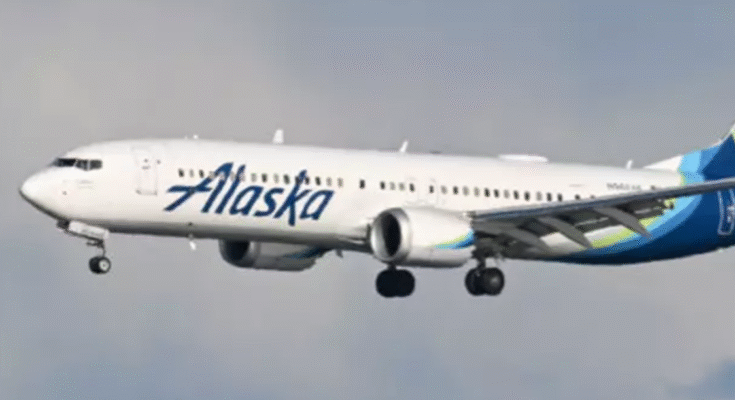The heartbreaking ordeal occurred 25 years ago and claimed the lives of everyone onboard
Harrowing cockpit audio revealed the moment an Alaska Airlines plane plummeted in the Pacific Ocean.
On January 31, 2000, Alaska Airlines Flight 261 was scheduled to travel from Licenciado Gustavo Díaz Ordaz International Airport in Puerto Vallarta, Jalisco, Mexico, to Seattle–Tacoma International Airport in Washington.
While the aircraft successfully left Mexico, it never made it to its final destination after the plane started to experience technical difficulties during the flight.
Ultimately, the plane ended up crashing into the Pacific Ocean, killing all 88 people, including 83 passengers, three cabin crew and two pilots, onboard.
Alaska Airlines CEO says ‘many’ planes found with loose bolts
25 years on from the tragic ordeal and it is still one of the worst aviation disasters in modern US history.
With this in mind, the heartbreaking incident is still being talked about to this day and cockpit audio has recently resurfaced on social media.
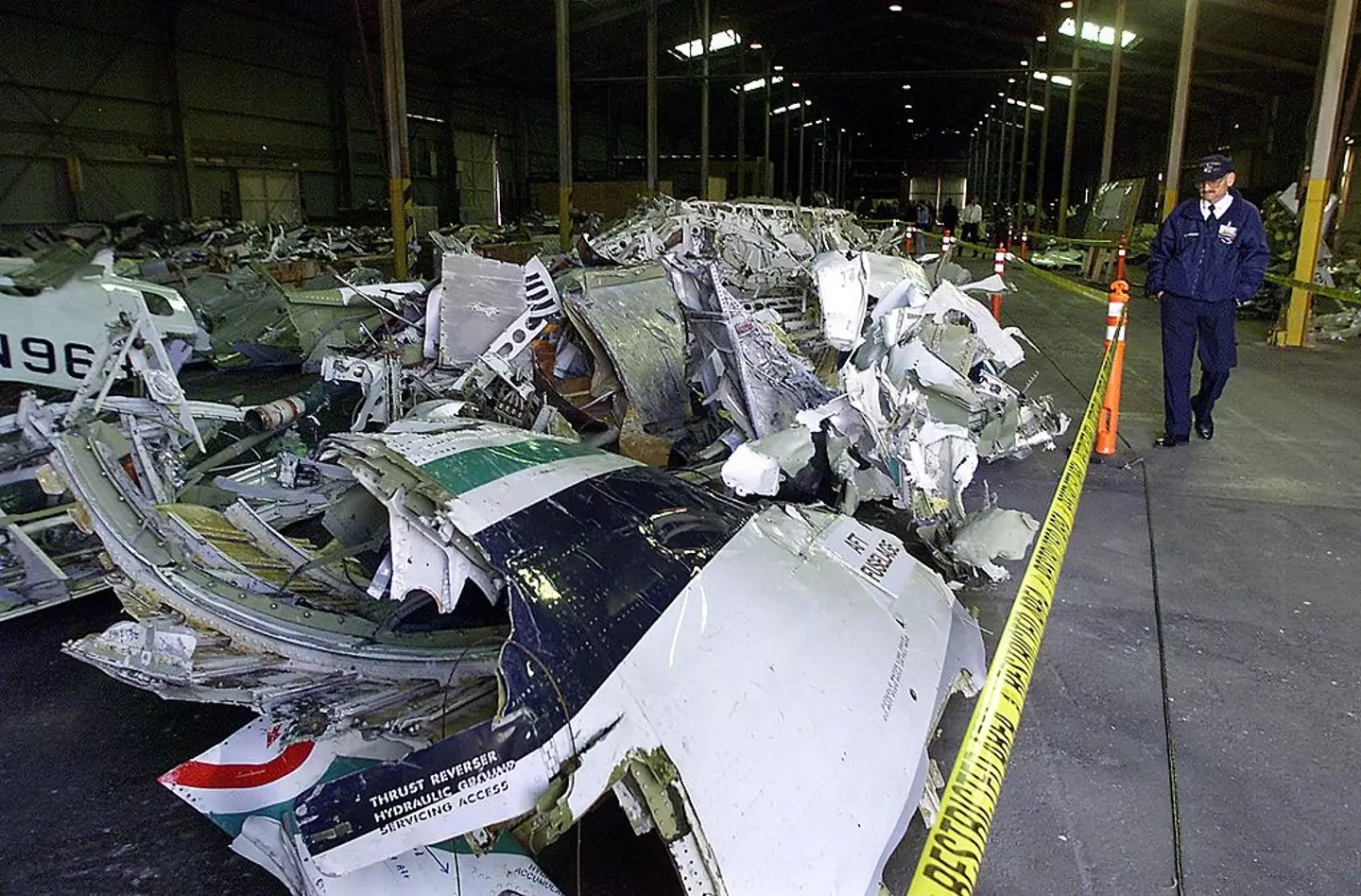
The aircraft was completely destroyed upon impact (MIKE NELSON/AFP via Getty Images)
The flight in question was being manned by Captain Ted Thompson, 53, and 57-year-old First Officer Bill Tansky, both of whom had flown a collective 12,000 hours in McDonnell Douglas MD-80s aircrafts, AeroTime reported.
But their vast amount of experience couldn’t save them as it was later revealed that part of the plane’s tail assembly failed due to a lack of lubrication of the jackscrew assembly.
In the resurfaced audio, Captain Thompson was heard telling air traffic control that they were ‘in a dive’.
He went on to explain: “Not a dive yet but we’ve lost vertical control of our airplane.”
Thompson then said they’d managed to get it under control, but First Officer Tanksy weighed in and said ‘no we don’t’.
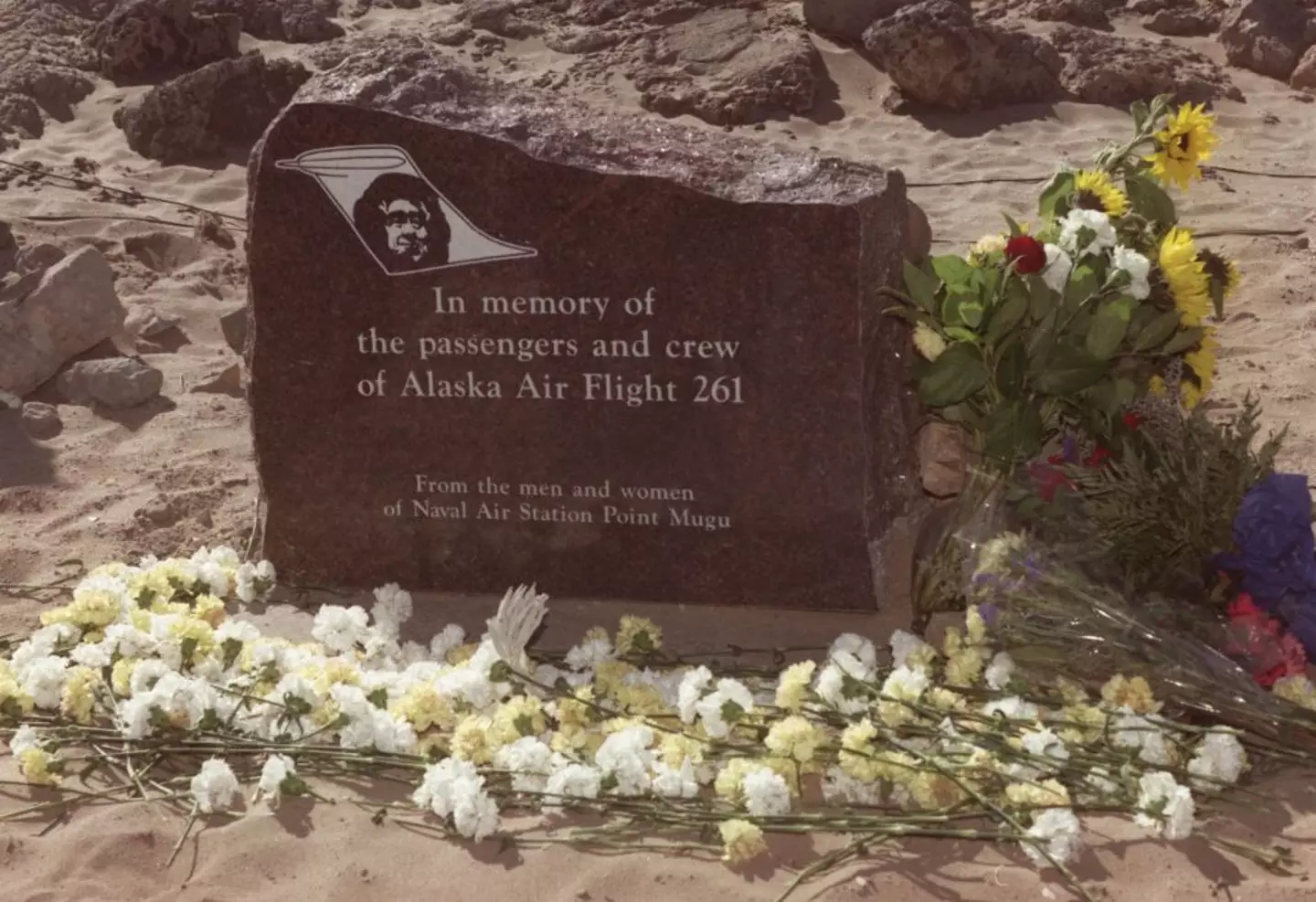
All 88 people onboard sadly died (Pool photo/Newsmakers)
Tanksy and Thompson proceeded to do some troubleshooting of the aircraft to try fix the issue.
The pair went quiet for a while an air traffic control officer chatted to another pilot in the air, believed to have been flying an Aero Commander 690A at the time, and requested to ‘keep an eye on [the Alaska Airlines flight]’.
It was this pilot who then informed air traffic control that the Alaska Airlines jet ‘just started to do a big, huge plunge’.
A second pilot confirmed what the other said and explained that Flight 261 was ‘definitely in a nose down position’.
Shortly after, the two planes that were watching the Alaska Airlines plane nosedive said that it had hit the water. The airplane was destroyed on impact.
The Federal Aviation Agency went on to investigate the crash.
In a statement, it said: “The National Transportation Safety Board (NTSB) determined that the probable cause of this accident was a loss of airplane pitch control resulting from the in-flight failure of the horizontal stabilizer trim system jackscrew assembly’s Acme nut threads.
“The thread failure was caused by excessive wear resulting from Alaska Airline’s insufficient lubrication of the jackscrew assembly.”Featured Image Credit: Tayfun Coskun/Anadolu via Getty Images
Topics: Social Media, Travel, News, US News, History
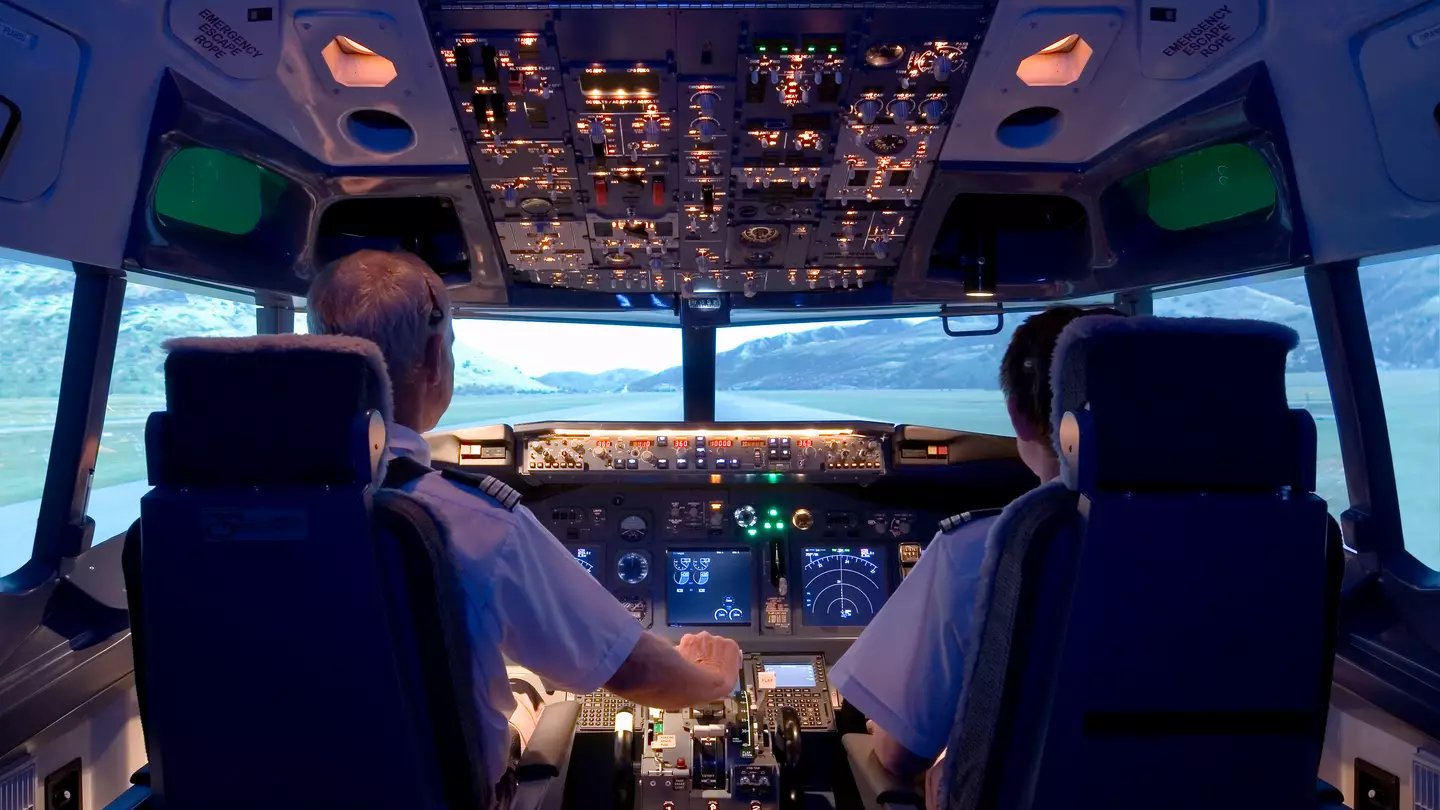
Updated 17:22 26 Jan 2025 GMTPublished 17:09 26 Jan 2025 GMT
Cockpit audio recording captures final moments before plane crashed into hillside killing three crew members
Four people died in total due to a tragic misunderstanding
An eerie recording capturing the final moments before a plane crashed on the approach to a busy capital city airport has gone viral.
Next month will mark the 36th anniversary of the fatal collision in Kuala Lumpur, Malaysia, where three crew members and one passenger were onboard.
On February 18, 1989, a Boeing 747-200 operated by Flying Tigers Line flying from Singapore Changi International Airport to Subang International Airport, in Kuala Lumpur, crashed nine miles to the south east of the runway.
The investigation into what happened described the incident as ‘not a survivable accident’, as it crashed into a hillside.
The incident took place shortly after 6.30am local time, with a sunrise typically taking place around 7.20am.
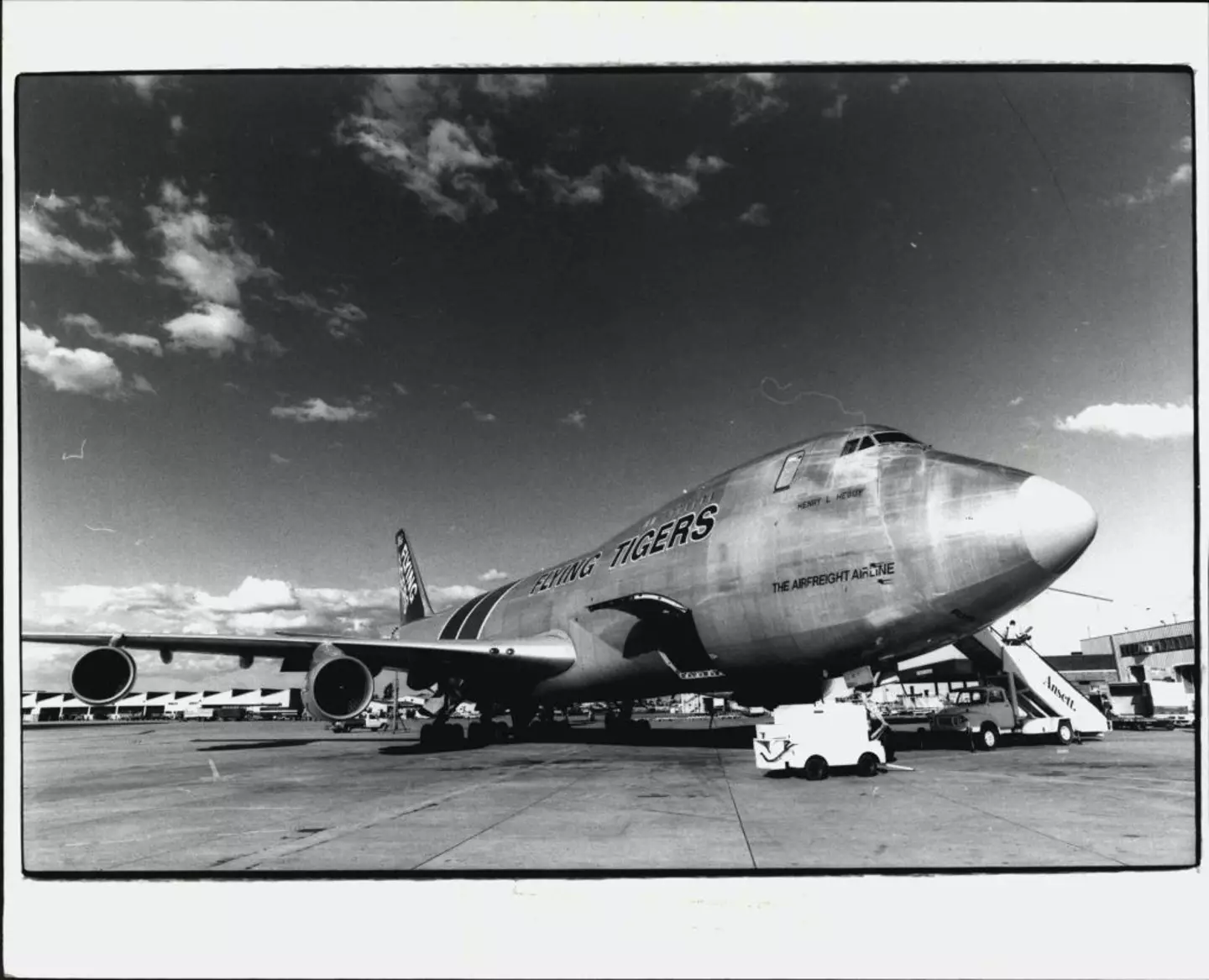
The Flying Tigers Line crashed just nine miles south east of its destination (Paul Wright/Fairfax Media via Getty Images)
Chilling cockpit audio
A recording from the cockpit was later made public, and has since been uploaded to Twitter.
“So you got the ILS [Instrument Landing System – which provides both vertical and lateral guidance information for pilots to allow safe landings to touchdown] set, right?” the captain asks his co-pilot.
The first officer responds: “Yeah.”
“I’m gonna put you on 14-7 [pilot code], that will give you…” the captain says, before cutting out as he realizes the plane is approaching a hillside.
“Oh,” another crew member says.
“I’ve got a hundred feet on this – S***!” adds someone in the cockpit.
Chillingly, for the entire 29-second recording, the ground proximity warning system is sounding – repeatedly saying ‘pull up’.
Cockpit recording of Flying Tiger crash
(Flying Tiger Line/Paul Wright/Fairfax Media via Getty Images)
0 seconds of 29 secondsVolume 90%
A fatal misunderstanding
An accident report concluded that the incident occurred due to the pilot misreading an announcement from ground control over the radio.
The conclusion, which includes aviation lingo, read: “The commander, after being cleared by ATC to carry out a NDB approach runway 33, misread the descent clearance and descended to 400ft instead of 2400ft.
“The descent to 400ft was initiated when the flight was still approximately 7 NM (nautical miles) prior to reaching the Kilo Lima beacon.
“Though the flight crew knowingly descended the aircraft, the descent profile was not in conformity with required NDB procedures.”
Responding to the incident on the social media platform Twitter, one user wrote: “Such a tragic event. This highlights the importance of proper training and communication in aviation safety.”
“Tragic incident highlighting the importance of crew coordination and adherence to procedures. A somber reminder of aviation safety,” added another.
A third penned: “In Years to come when People look back at our Mode of Air Transport and realise the risks we took Flying about in an inflatable Aluminium Tube filled with Explosive Flammable Liquid they will definitely question our Sanity!”Featured Image Credit: Getty stock
Topics: World News, Travel, Twitter
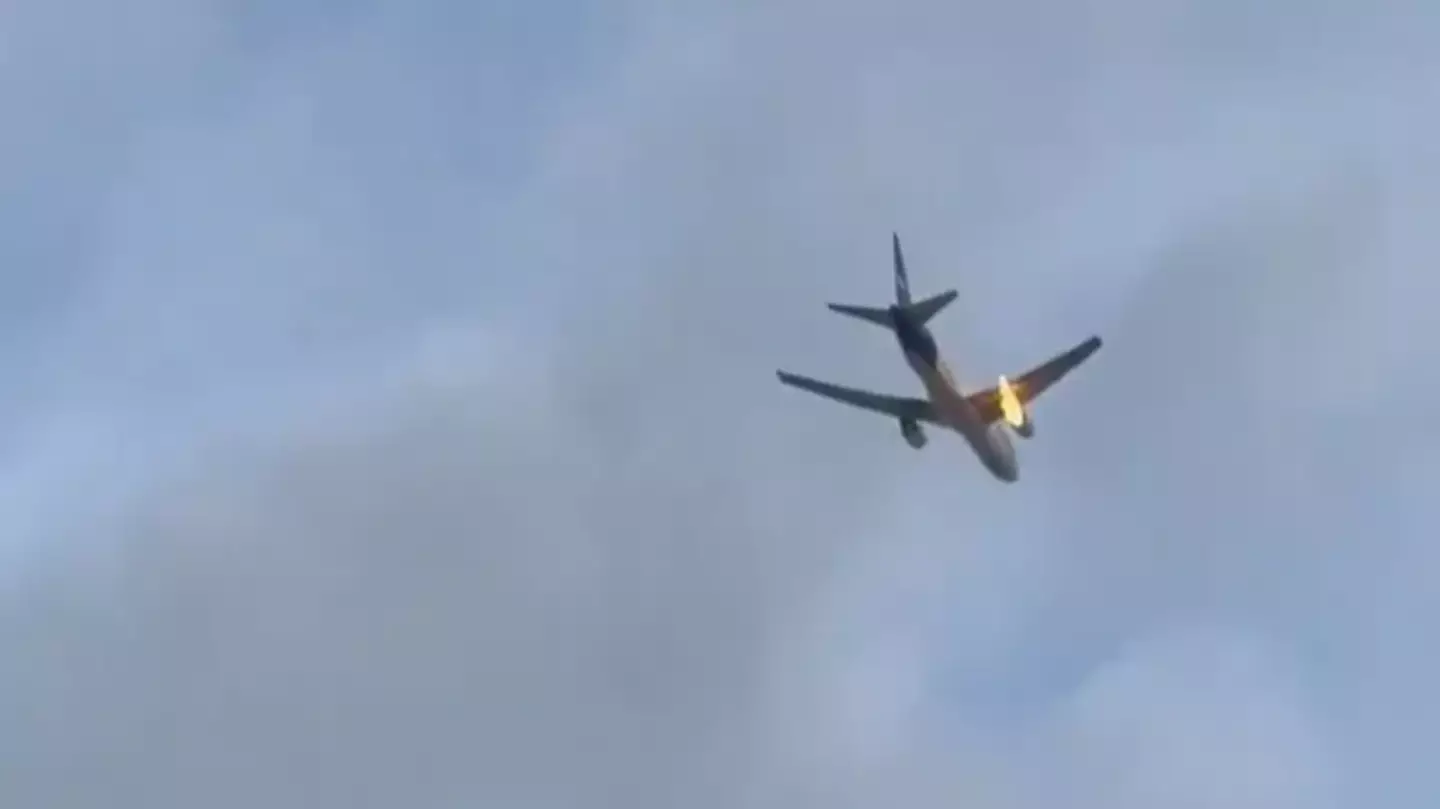
Published 10:00 2 Mar 2025 GMT
Audio recording captures moments after FedEx plane catches fire midair causing emergency landing
A video shows the Boeing 767-3S2F scrambling to get back onto the tarmac
A FedEx plane was filmed as its engine suddenly burst into flames just moments after taking off from an airport.
After a slew of aeroplane issues in the last few months, a plane for the global delivery service has become the latest victim after leaving Newark Airport on Saturday February 1.
A video, which has been released to the public via news broadcasts, shows the Boeing 767-3S2F scrambling to get back onto the tarmac as one of its engines was engulfed in flames at approximately 8am.
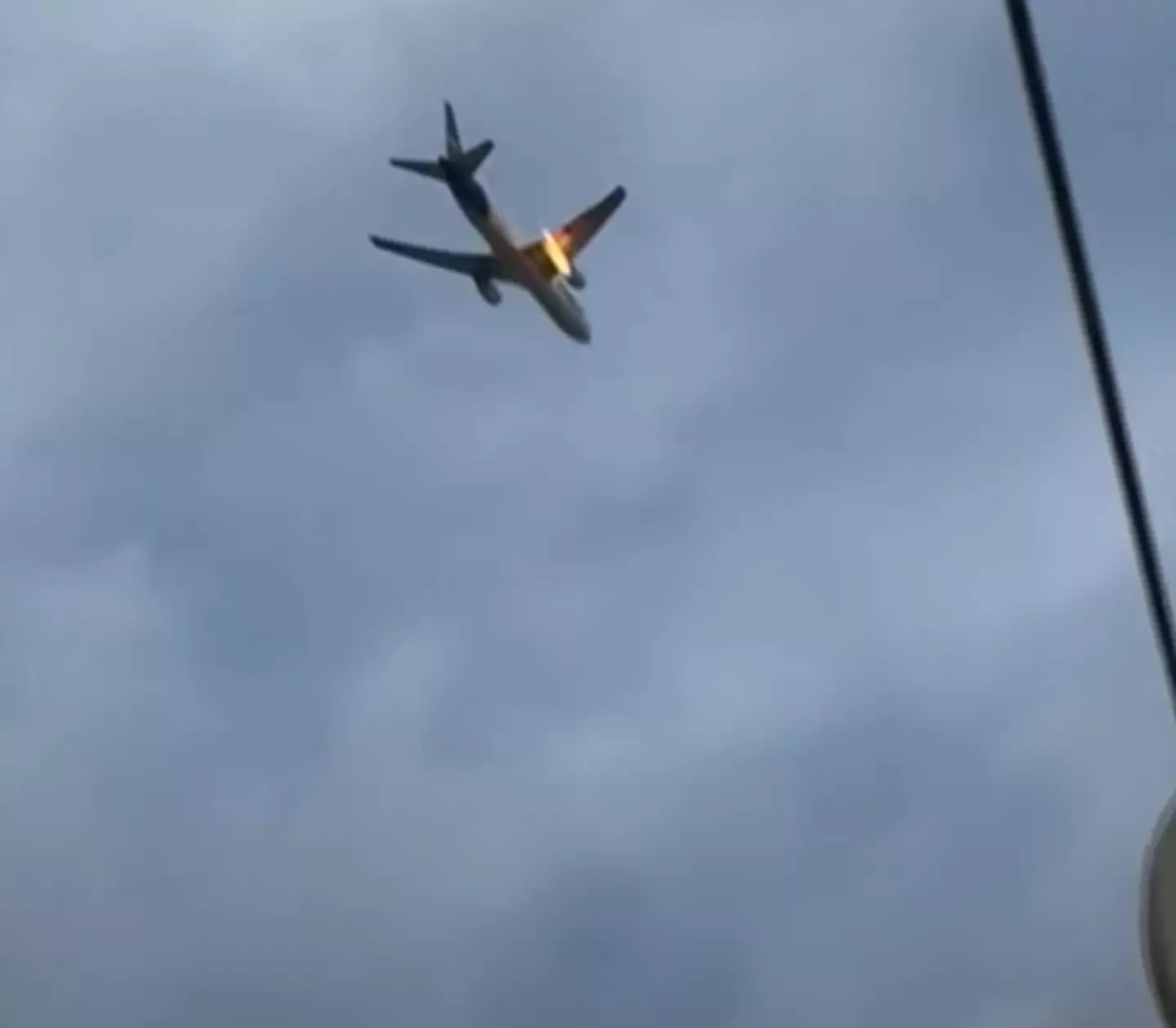
The FedEx plane’s engine burst into flames (YouTube/CBS Evening News)
The ordeal lasted a short time, as once the engine burst into flames, the plane quickly made an emergency landing, where it was met on the ground by two Port Authority fire trucks, which promptly worked to extinguish the flames.
The National Transportation Safety Board has now opened an investigation into the incident to find out what caused the plane to go up in flames. However, it is believed that it was due to a bird strike– the same issue which is also believed to have caused a Jeju airliner to crash land in South Korea, killing all on board.
According to the spokesperson of the Port Authority of New York and New Jersey and FedEx, Lenis Valens, there were no reported injuries, and fire was contained to the engine.
Audio recorded by LiveATC revealed a person telling the craft to ‘shut down for a possible bird strike’ and that ‘we need to return to the airport.’
Moments later, another person said: “We believe we saw their engine fall off the right wing.”
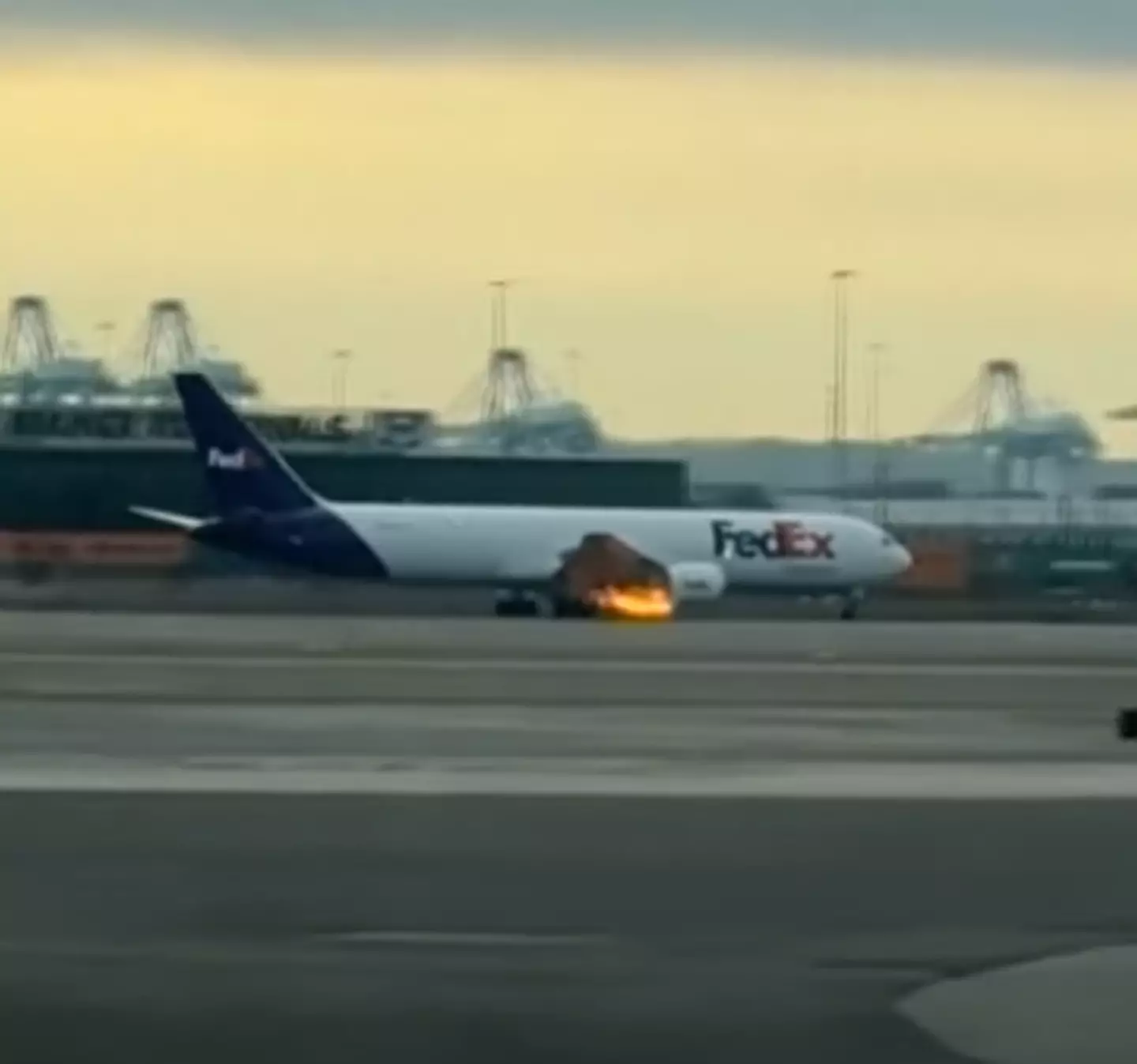
The plane made an emergency landing (YouTube/CBS Evening News)
A FedEx representative told The Post that the plan landed at 8:07am, nine minutes after takeoff, stating: “FedEx Flight 3609 from Newark to Indianapolis experienced a bird strike during takeoff. Our crew declared an emergency and returned safely to Newark. We are thankful for the quick actions of our crew and first responders.”
However, the plane was then cleared to leave for Indiana at 9:30am, according to Flight Aware with The Federal Aviation Administration stating that the bird ‘strike damaged one of the Boeing 767’s engines.’
This plane incident is just one of many that have swept the globe.
On Tuesday February 25, a Southwest plane almost collided with a private jet on the runway at Chicago Midway Airport when the private plane rolled in its path.Play
On February, 24 a Delta Air Lines flight to South Carolina was forced to return to Atlanta when ‘haze’ and smoke began to pour into the cabin.
A Canadian plane was seen all over social media after it crash landed, skidded and rolled onto its back, leaving all passengers alive but shaken up.
Then, there was the Black Hawk helicopter incident over Potomac River, which collided with a commercial plane, killing 67 people, many of whom were children and young competitive figure skaters and their parents, and coaches.
The seeming uptick in plane issues has brought forward an onslaught of worries about air travel safety, and why bird strikes appear to be becoming more frequent occurrences.
UNILAD reached out to the National Transportation Safety Board, FedEx and the Port Authority of New York and New Jersey for comment.Featured Image Credit: YouTube/CBS Evening News

Updated 11:16 1 Feb 2025 GMTPublished 11:13 1 Feb 2025 GMT
Family of American Airlines pilot reveals heartbreaking final conversation before the plane crashed
American Airlines pilot Jonathan Campos is one of the 67 people believed to have died after a passenger plane hit a military helicopter
The uncle of American Airlines pilot Jonathan Campos has opened up about their last phone conversation as he was ‘boarding the plane’.
On Wednesday (January 29) at 8.47pm ET, an American Airlines passenger plane – flight 5342 – and a US military helicopter collided mid-air over the Potomac River, close to the Ronald Reagan National airport in Washington DC.
The passenger plane was carrying 64 passengers and crew and had traveled from Wichita, Kansas, while the army helicopter – a Sikorsky H-60 Black Hawk carrying three crew – had taken off from Fort Belvoir, Virginia.
Man who witnessed American Airlines plane crash describes seeing ‘white flare’
Credit: WUSA9
0 seconds of 1 minute, 29 secondsVolume 90%
All 64 passengers onboard the passenger plane alongside the helicopter’s three crew members are believed dead.
An investigation into the incident was immediately launched by the National Transportation Safety Board which recovered the black boxes from both the aircraft.
Prior to the crash, pilot of the American Airlines plane Jonathan Campos had a phone conversation with his uncle.
In an interview with the MailOnline, Campos’ uncle John Lane explained he spoke to his nephew ‘for 10 minutes’ as he was boarding the plane and he ‘sounded really happy’.
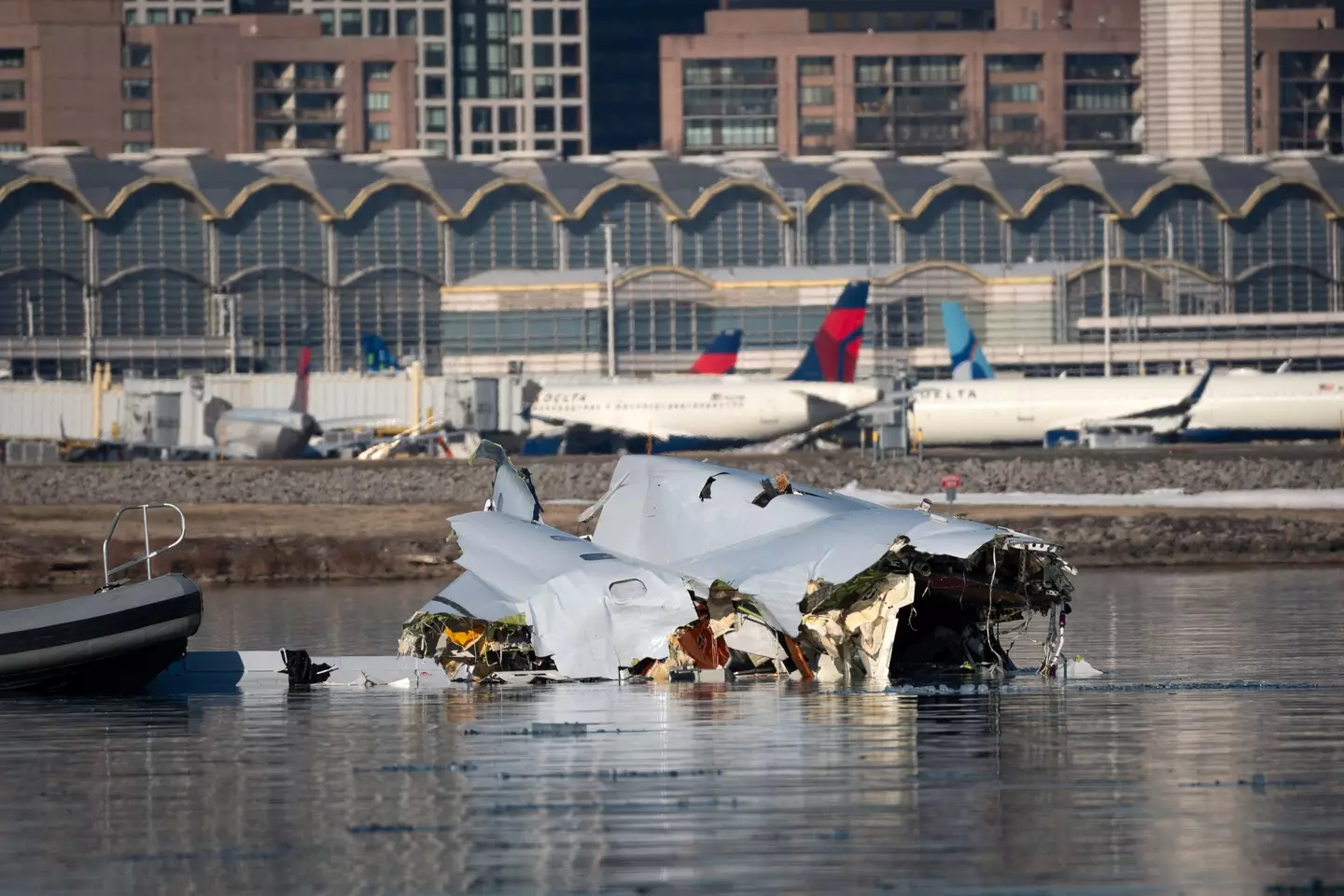
The American Airlines plane and helicopter wreckage ended up in the Potomac River (Petty Officer 1st Class Brandon Giles/ U.S. Coast Guard via Getty Images)
He said: “I can’t believe it. He sounded really happy. He was looking forward to going on a cruise next week on the Icon of the Seas, the cruise ship.
“Ten family members were going to fly to Florida to take the trip with him. It was going to be a big celebration.”
Lane reflected on how it was always Campos’ ‘dream’ to become a pilot and he used to play with ‘toy planes’ as a child.
Having been to flight school six years ago and doing ‘so well with his life’, his ambition was eventually to ‘qualify to fly bigger planes’.
Campos’ uncle noted the rest of the family feel ‘sick right now’ but resolved how ‘proud of him’ they are of him and what a ‘good kid’ he was.
American Airlines issued a statement on the incident which reads: “American Eagle Flight 5342 en-route from Wichita, Kansas (ICT), to Washington, D.C. (DCA) was involved in an accident at DCA. The flight was operated by PSA Airlines with a CRJ-700.

Jonathan Campos and his uncle spoke as he was boarding the flight (Facebook)
“There were 60 passengers and four crew members on board the aircraft. Our concern is for the passengers and crew on board the aircraft. We are in contact with authorities and assisting with emergency response efforts.
“If you believe you may have loved ones on board Flight 5342, call American Airlines toll-free at 800-679-8215. Those calling from outside the U.S. can visit news.aa.com for additional phone numbers. Family members in Canada, Puerto Rico or the U.S. Virgin Islands can call 800-679-8215 directly.”
If you have experienced a bereavement and would like to speak with someone in confidence, contact GrieveWell on (734) 975-0238, or email info@grievewell.com.Featured Image Credit: Facebook
Topics: US News, American Airlines, Travel, Pilot, Florida

Published 21:11 18 Jun 2024 GMT+1
Harrowing footage captures the moment plane flipped over and crashed during landing
China Airlines Flight 642 never made it to its intended destination.
Almost 25 years ago, China Airlines Flight 642 jetted off from Bangkok and was due to fly to Taipei with a stopover in Hong Kong – but a tropical storm caused a disaster to unfold.
On August 22 1999, 300 passengers and 15 crew members boarded a McDonnell Douglas MD-11 at Bangkok‘s Don Mueang International Airport.
The onboard holidaymakers were due to travel on the trijet to Taipei’s Chiang Kai-shek International Airport after a scheduled layover at Hong Kong International Airport.
China Airlines Flight 642 crashes at Hong Kong International Airport
X/planesanity
0 seconds of 59 secondsVolume 90%
According to the aircraft accident report, the pilot had 17,900 flight hours under his belt, including 3,260 hours on the MD-11.
Meanwhile, the first officer for China Airlines Flight 642 had logged an impressive 4,630 flight hours.
Despite their experience, they were face with challenging weather conditions.
Severe Tropical Storm Sam – which formed five days earlier – was still raging and caused various flight diversions and forced pilots to complete go-arounds.
Despite environmental difficulties, Flight 642 continued towards its planned stopover.
However, due to the tropical storm, the aircraft’s right wing was slightly down at the time that the landing flare was attempted.

A report claimed the plane crash was mainly due to pilot error. (X/@planesanity)
Moreover, the flight was close to its maximum permitted landing weight due to carrying enough fuel to divert directly to Taipei in the event of being unable to touch down in Hong Kong.
With the wing being down and the heavy hull, the trijet came down hard on its starboard landing gear, as per Simpleflying.
The China Airlines flight made contact with the ground, causing the wing to separate and the jet to roll over.
The abundance of fuel onboard caused the inverted plane to go up in flames as it skidded 1,100 meters from the threshold of one of the airport’s runways.
Following the jet roll, emergency services arrived on the scene and suppressed the fire.
In a video taken at the scene of the incident, witnesses can be seen remarking the plane was ‘a bit shaky’ as it came down before remarking in horror as it went up in flames.
.jpg)
Horrified onlookers caught the aircraft crash on camera. (X/@planesanity)
According to a Civil Aviation Department Hong Kong Accident Investigation Division report, two passengers were pronounced dead at the scene while another died five days later in hospital.
“A total of 219 persons, including crewmembers, were admitted to hospital, of whom 50 were seriously injured and 153 sustained minor injuries,” they wrote.
An investigation into the wreck was later conducted, with officials declaring pilot error to have been the key factor in the horrific crash.
The error specified was the aircrew’s inability to arrest the high rate of descent existing at 50 feet on the radar altimeter.
Later, China Airlines disputed the report’s findings on the pilot and co-pilot and claimed the aircraft flew into a microburst before landing, causing it to crash.Featured Image Credit: X/@planesanity
Topics: China, History, Travel, World News
